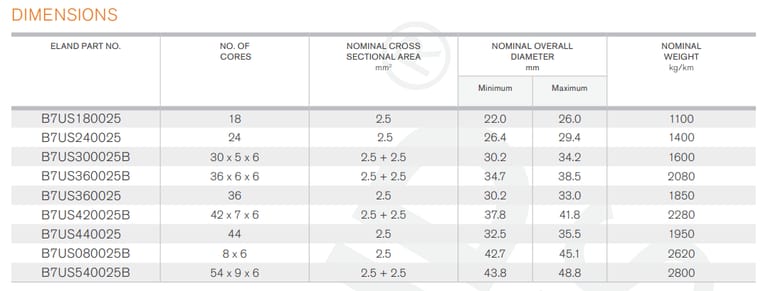Anhui Feichun Special Cable Co.,Ltd Li.wang@feichuncables.com

PUR Spreader LV Reeling Cable
PUR Spreader LV Reeling Cable: A Robust Solution for High-stress Industrial Applications
PUR Spreader LV Reeling Cable
APPLICATION | |
Usage | Vertical reeling cable under high mechanical stresses, torsion, tension, and torque. Mainly used for spreader reeling applications. |
Features | Strength member to increase tensile load, acceleration, and speed. PUR sheath offers very good protection against hydrolysis, solvents, alkalines, and oils. |
CHARACTERISTICS | |
Voltage Rating (Uo/U) | 0.6/1kV |
Temperature Rating | Fixed installation: -50°C to +90°C |
Minimum Bending Radius | Fixed Application: 6 x Overall Diameter |
Maximum Tensile Load | 30 N/mm² |
Maximum Torsion | ±25º/m |
Travel Speed | Festoon Systems: Up to 240m/min |
CONSTRUCTION | |
Conductor | Class 5 flexible stranded copper |
Insulation | Halogen-free compound based on polyester |
Lay Up | Central Aramid strength member, cores in concentric layers |
Inner Sheath | PUR-HF (Halogen Free, flame retardant Polyurethane) |
Braiding | Anti-twisting element - Aramid yarns braiding |
Outer Sheath | PUR-HF (Halogen Free, flame retardant Polyurethane) |
STANDARDS | |
Compliance | IEC 60228, DIN VDE 0293-308, IEC 60502, VDE 0250, DIN VDE 0472-501, 502, 503, 508, DIN VDE 0472-401, 402, 602, 303, 615, DIN VDE 0250-1, IEC 60502, IEC 60332-1, HD/EN/IEC 60811-2-1, DIN VDE 0473-811-2-1 |

Introduction:
In the relentless world of heavy industry, where massive machines roar to life under extreme conditions, reliable power delivery is not just a convenience—it's a lifeline. Enter the PUR Spreader LV Reeling Cable, a marvel of cable technology engineered for the toughest environments. This low-voltage (LV) reeling cable, with its polyurethane (PUR) sheath, stands out as a beacon of durability and efficiency. Designed specifically for spreader reeling applications—think container cranes hoisting massive loads or mining conveyors snaking through underground tunnels—it withstands torsion, tension, and torque that would snap lesser cables like twigs.
But what makes the PUR Spreader LV Reeling Cable so indispensable? At its core, it's a fusion of advanced materials and precise construction that ensures uninterrupted power flow in dynamic, high-mechanical-stress scenarios. With a voltage rating of 0.6/1kV, it powers equipment from -50°C to +90°C in fixed installations, making it ideal for everything from Arctic drilling rigs to sun-baked South African ports. As industries worldwide grapple with downtime costs that can run into millions, this cable isn't just wiring—it's a strategic asset.
Installation Best Practices
Start with site prep: Assess environmental factors like temperature extremes and chemical exposure, which the PUR sheath handles admirably but still warrant precautions. For reeling setups, mount drums securely to minimize vibrations, adhering to the 8x diameter bending radius for mobile use. Use certified glands for terminations to maintain the cable's IP ratings against dust and water ingress.
Layering is key: During lay-up, ensure the central aramid member is tensioned evenly to distribute loads. In vertical applications, like crane spreaders, incorporate anti-twist guides to leverage the ±25º/m torsion tolerance. Testing is non-negotiable—apply the 0.6/1kV rating's proof voltage per DIN VDE 0250-1 before commissioning. For festoon systems, route cables in protective troughs to shield from abrasion, capping speeds at 240 m/min to avoid overheating.
Maintenance Strategies: Proactive Over Reactive
Routine checks are the cable's best friend. Visually inspect sheaths quarterly for cuts or discoloration—PUR's oil resistance buys time, but early detection prevents escalation. Use thermal imaging to spot hotspots, ensuring temps stay within -40°C to +90°C mobile limits. For aramid integrity, perform periodic tensile tests up to 30 N/mm²; any degradation signals replacement.
Lubrication of reels with compatible greases (PUR-safe, non-alkaline) reduces friction, extending life. In high-torsion zones, monitor for braiding wear via ultrasonic scans. Adhere to VDE 0472-501/502 standards for flame tests during overhauls. Downtime? Minimal—modular designs allow section swaps without full disassembly.
By following these, operators report 20-30% longer service intervals, slashing total ownership costs. Remember, the PUR Spreader LV Reeling Cable thrives on care; neglect it, and even its robust build falters.
Usage Scenarios:
The PUR Spreader LV Reeling Cable shines in scenarios demanding unyielding reliability: vertical reeling under high stresses, like ship-to-shore cranes or mining hoists. Its strength member amplifies tensile loads, acceleration, and speed, while the PUR sheath fortifies against industrial nasties.
Globally, it's a staple in container terminals, powering spreaders that lift 40-ton loads at blistering paces. In festoon systems, it snakes along overhead tracks, delivering 0.6/1kV to automated stackers without a hitch.
Now, zoom to South Africa, where mining and ports form the economic backbone. In the gold-rich Witwatersrand Basin, operations like those at Anglo American's Moab Khotsong mine deploy PUR Spreader variants for underground reeling. Here, the cable's -50°C fixed rating combats chilly depths, while aramid braiding tames torque from twisting conveyors hauling ore. A 2023 upgrade at a similar site reduced cable failures by 40%, boosting uptime in a sector where every minute offline costs R1 million.

Feichun Special Cables
Email Address: Li.wang@feichuncables.com
© 2025. All rights reserved.


One-click to Quickly Contact
Products
Offshore & Marine Cable
XLPE Cable
Contact
Company
Location:
Building A Private Science and Technology Park, Hefei Economic and Technological Development Zone, Anhui Province, China
